- Get link
- X
- Other Apps
 WHAT IS AKSHARDHAM
WHAT IS AKSHARDHAM
SPIRITUAL SIGNIFICANCE
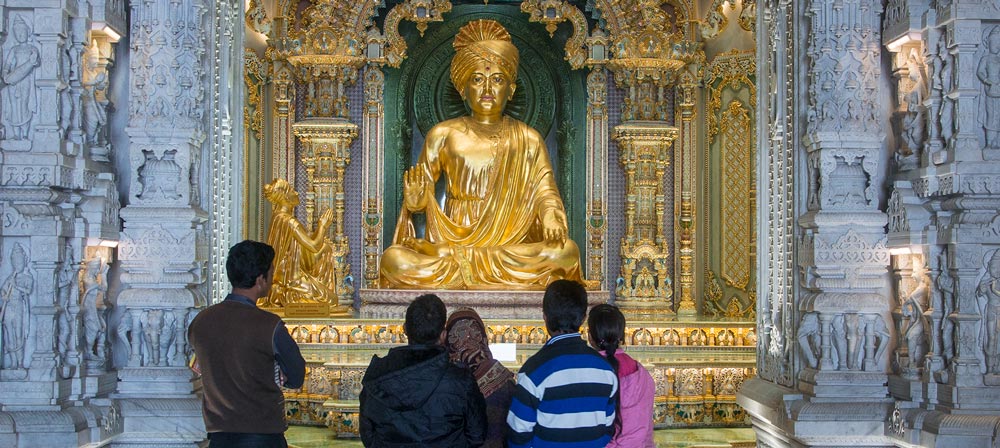
Each element of Akshardham echoes with spirituality – the Mandir, the Exhibitions and even the Gardens.
The Akshardham mandir has over two hundred murtis, representing many of the spiritual stalwarts over many millennia. The spiritual premise of Akshardham is that each soul is potentially divine. Whether we are serving the family, the country our neighbors or all living beings the world over , each service can help one move towards divinity. Each prayer is a call towards improving oneself and moving closer to God.
A visit to Akshardham is a spiritually enriching experience. Whether it is in realising the power of prayer, in feeling the strength of non-violence, in being aware of the universal nature of Hinduism’s ancient principles, or just in admiring the beauty of God’s abode on Earth –- each element has a spiritual significance.
The Akshardham mandir has over two hundred murtis, representing many of the spiritual stalwarts over many millennia. The spiritual premise of Akshardham is that each soul is potentially divine. Whether we are serving the family, the country our neighbors or all living beings the world over , each service can help one move towards divinity. Each prayer is a call towards improving oneself and moving closer to God.
A visit to Akshardham is a spiritually enriching experience. Whether it is in realising the power of prayer, in feeling the strength of non-violence, in being aware of the universal nature of Hinduism’s ancient principles, or just in admiring the beauty of God’s abode on Earth –- each element has a spiritual significance.
FACTS AND FIGURES
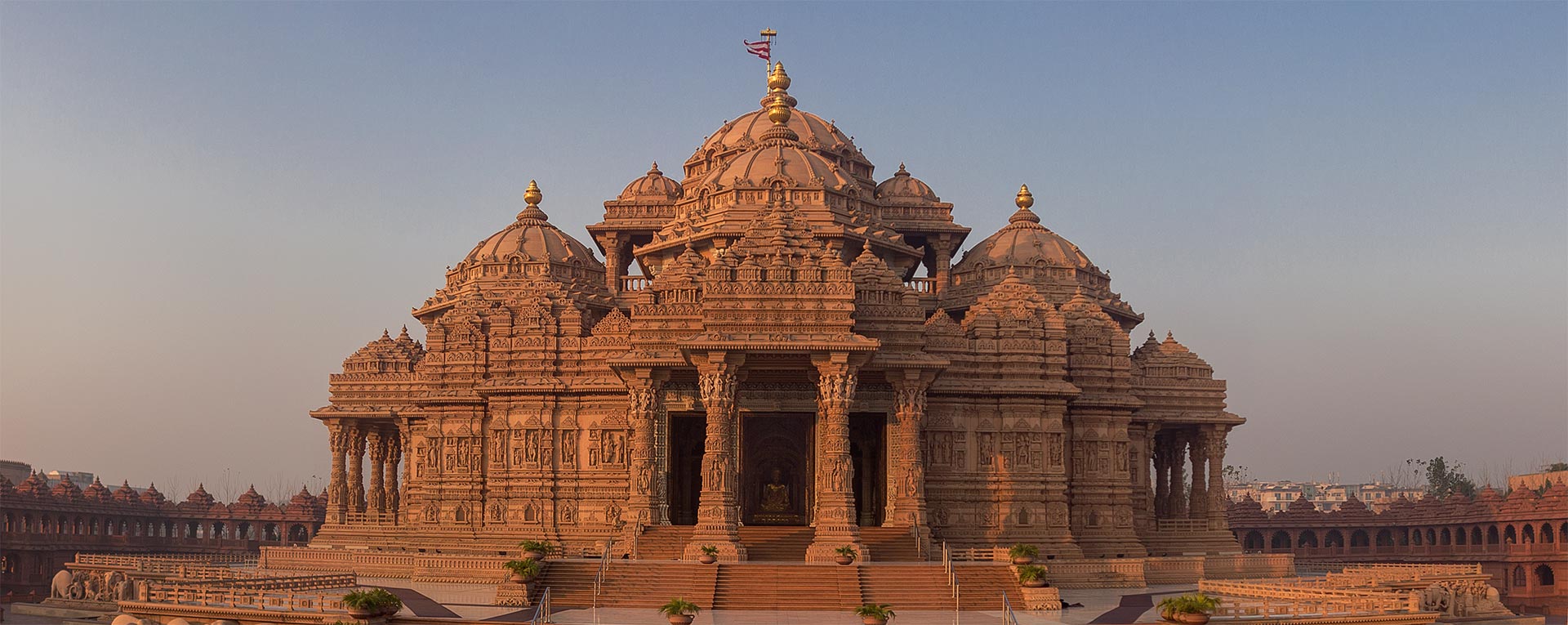
- Opened 6th November 2005
- Constructed by Bochasanwasi Shri Akshar Purushottam Swaminarayan Sanstha (BAPS)
- Inspired by HH Yogiji Maharaj (1892-1971 CE)
- Created by His Holiness Pramukh Swami Maharaj
- More than 300,000,000 volunteer hours went into making the complex
- Over 8,000 volunteers from across the world participated in building it
- Mandir built from intricately carved sandstone and marble
- Exhibitions on Hinduism, including Bhagwan Swaminarayan's life and teachings such as prayer, compassion, and non-violence.
- Open gardens, water bodies and step-well styled courtyard
MANDIR
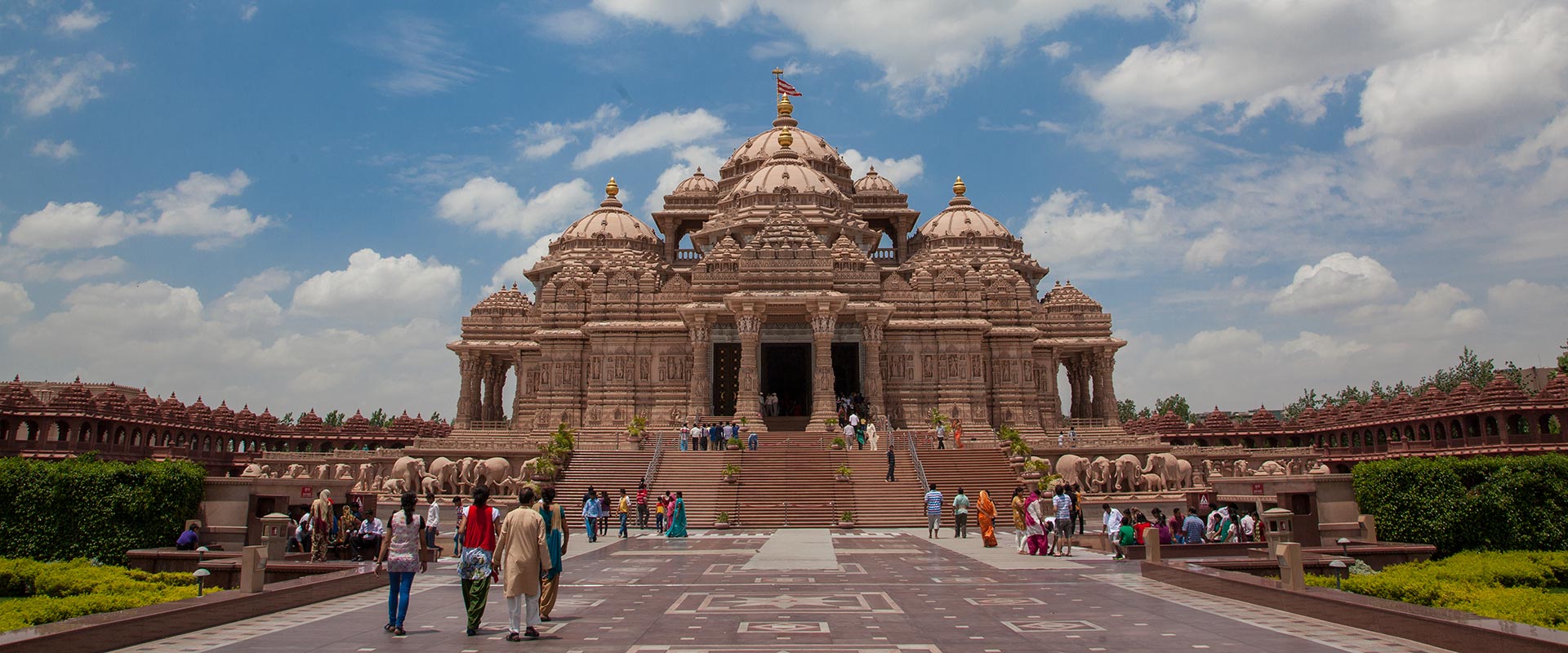
The heart of the Swaminarayan Akshardham complex is the Akshardham mandir.
Inaugurated on 6 November 2005, the mandir is an effort to offer a home to God that honors . His glory and divinity –- a timeless, beautiful and peaceful home for God here on Earth. It is a temporal abode of God and the devotion, values and culture He inspires.
Architecturally, the mandir is an homage to traditional Indian Hindu architecture. It is designed with an eye to The ancient and middle-agemedieval Indian treatises on architectural science, - the shilpa shastras, have guided the mandir’s design and construction from its distinctive style of carving and its proportions to its avoidance of .
Accordingly, the mandir is made without the use of ferrous metal in construction.
The Akshardham mandir consists of 234 intricately carved pillars, 9 ornate domes, 20 quadrangled spires and 20,000 statues of India’s Hinduism’s spiritual personalities. The mandir reaches 141.3 feet into the sky, spans 316 feet in width,
and is 356 feet long.
Inside the mandir, each worshipfully carved pillar, ceiling and dome shares a story of devotion, offers darshan of a deity, or captures an incident from the life of Bhagwan Swaminarayan.
Inaugurated on 6 November 2005, the mandir is an effort to offer a home to God that honors . His glory and divinity –- a timeless, beautiful and peaceful home for God here on Earth. It is a temporal abode of God and the devotion, values and culture He inspires.
Architecturally, the mandir is an homage to traditional Indian Hindu architecture. It is designed with an eye to The ancient and middle-agemedieval Indian treatises on architectural science, - the shilpa shastras, have guided the mandir’s design and construction from its distinctive style of carving and its proportions to its avoidance of .
Accordingly, the mandir is made without the use of ferrous metal in construction.
The Akshardham mandir consists of 234 intricately carved pillars, 9 ornate domes, 20 quadrangled spires and 20,000 statues of India’s Hinduism’s spiritual personalities. The mandir reaches 141.3 feet into the sky, spans 316 feet in width,
and is 356 feet long.
Inside the mandir, each worshipfully carved pillar, ceiling and dome shares a story of devotion, offers darshan of a deity, or captures an incident from the life of Bhagwan Swaminarayan.
GARBHAGRUH
The inner sanctum or garbhagruh of the Akshardham mandir is home to Bhagwan Swaminarayan and his divine succession of gurus - Gunatitanand Swami, Bhagatji Maharaj, Shastriji Maharaj, Yogiji Maharaj, and Pramukh Swami Maharaj.
As manifestations of Aksharbrahma, the gurus, as manifestations of Aksharbrahma, are God’s eternal servants and ideals of saintliness and devotion.
They reside in the garbhagruh eternally offering service and worship to Bhagwan Swaminarayan. Items sanctified by Bhagwan Swaminarayan during his time on Earth are also preserved for darshan directly behind the garbhagruh.
Around the garbhagruh, special altars are devoted to other Hindu deities of Sanatana Dharma: Shri Sita-Ram, Shri Radha-Krishna, Shri Lakshmi-Narayan, and Shri Shiv-Parvati.
As manifestations of Aksharbrahma, the gurus, as manifestations of Aksharbrahma, are God’s eternal servants and ideals of saintliness and devotion.
They reside in the garbhagruh eternally offering service and worship to Bhagwan Swaminarayan. Items sanctified by Bhagwan Swaminarayan during his time on Earth are also preserved for darshan directly behind the garbhagruh.
Around the garbhagruh, special altars are devoted to other Hindu deities of Sanatana Dharma: Shri Sita-Ram, Shri Radha-Krishna, Shri Lakshmi-Narayan, and Shri Shiv-Parvati.
MANDAPAMS
The interior of the Akshardham mandir can be divided into nine mandapams or thematic spaces. These nine mandapams are each filled with intricately carved murtis and pillars and capped by unique domes and ceilings. Travelling through these mandapams, one meets renowned devotees, great avatars and rejoicing celestial beings. The ornate designs and intricate carvings of the mandapams inspire reflection of God’s inconceivable beauty and the beauty he inspires in creation.
MANDOVAR

The external facade of a traditional stone temple is known as a mandovar. Swaminarayan Akshardham's mandovar is the largest, most intricately carved mandovar built in India in the last eight hundred years. It is 25 feet high, 611 feet long and features 200 sculptured stone figures of many of Hinduism’s great rishis, sadhus, devotees, acharyas and avatars.
The base of the mandovar is called the jagati. In this layer, one finds carvings of living beings from our everyday world. First, we have the elephant which is a symbol of strength, then the lion, which symbolizes bravery and ferocity. Thereafter, one finds the vyal (a Pauranic animal) that was renowned for speed.
In the subsequent layers, one finds carvings of flowers that stand for beauty and fragrance. In the middle of the mandovar, known as vibhuti, are sculptures of the avatars, sages, devas, acharyas and devotees.
And on top within this layer are the samarans that exhort people to strive for spiritual height in life. The entire mandovar inspires an individual to liberate his life from the shackles of mundane pleasures and ascend to the ultimate state of God-realization.
The base of the mandovar is called the jagati. In this layer, one finds carvings of living beings from our everyday world. First, we have the elephant which is a symbol of strength, then the lion, which symbolizes bravery and ferocity. Thereafter, one finds the vyal (a Pauranic animal) that was renowned for speed.
In the subsequent layers, one finds carvings of flowers that stand for beauty and fragrance. In the middle of the mandovar, known as vibhuti, are sculptures of the avatars, sages, devas, acharyas and devotees.
And on top within this layer are the samarans that exhort people to strive for spiritual height in life. The entire mandovar inspires an individual to liberate his life from the shackles of mundane pleasures and ascend to the ultimate state of God-realization.
NARAYAN PEETH

It is an ancient Hindu tradition to perform pradakshinas or circumambulations as a sign of respect and prayers. The faithful walk clockwise around mandirs to reinforce the belief that God should be the center of one’s life.
At the Akshardham mandir, the path for performing these circumambulations is embellished with three 60 feet long bronze relief panels. These panels illustrate divine incidents from the life of Bhagwan Swaminarayan and help the faithful walking these paths to remember God as they perform circumambulations. The layer of the mandir where these panels are installed is known as the Narayan Peeth.
At the Akshardham mandir, the path for performing these circumambulations is embellished with three 60 feet long bronze relief panels. These panels illustrate divine incidents from the life of Bhagwan Swaminarayan and help the faithful walking these paths to remember God as they perform circumambulations. The layer of the mandir where these panels are installed is known as the Narayan Peeth.
GAJENDRA PEETH
A mandir stands, traditionally and symbolically, on the shoulders of elephants. In a uniquely creative adaptation, the elephants at the base of Swaminarayan Akshardham are not just standing still. The Gajendra Peeth or Elephant Plinth presents stories and legends of elephants with nature, with humans and with God. This depiction of elephants is to honor these grand yet gentle animals and also share messages of peace, beauty and gentleness.
GAJENDRA PEETH

The Gajendra Peeth, the lower pradakshina, is a unique, captivating feature of Swaminarayan Akshardham and is an inspiring revival of an ancient architectural tradition. Ancient architectural treatises like Mayamtam, Shilpa Ratnakar, Diparnav and others prescribe a gajsthar (plinth of elephants) for palaces and mandirs. This tradition is found in the ancient Kailas Mandir of Ellora, which is 1300 years old and in the Mahabalipuram Mandir that is 1400 years old. Prior to the 12th century, many mandirs followed this tradition by having a gajsthar. The large gajsthar of the Swaminarayan Akshardham marks a bold return of this tradition.
Akshardham’s unique revival of this tradition comes with a new inspirational, artistic innovation. Instead of the sequential replication as seen in old mandirs, it portrays inspiring incidents related to elephants – such as how elephants and humans share close relationships, how elephants were blessed by the divine and stories from the Panchtantra.
Below are some samples of these stories as carved in Swaminarayan Akshardham’s Gajendra Peeth.
Akshardham’s unique revival of this tradition comes with a new inspirational, artistic innovation. Instead of the sequential replication as seen in old mandirs, it portrays inspiring incidents related to elephants – such as how elephants and humans share close relationships, how elephants were blessed by the divine and stories from the Panchtantra.
Below are some samples of these stories as carved in Swaminarayan Akshardham’s Gajendra Peeth.
THE GOAT, THE LION AND THE ELEPHANT
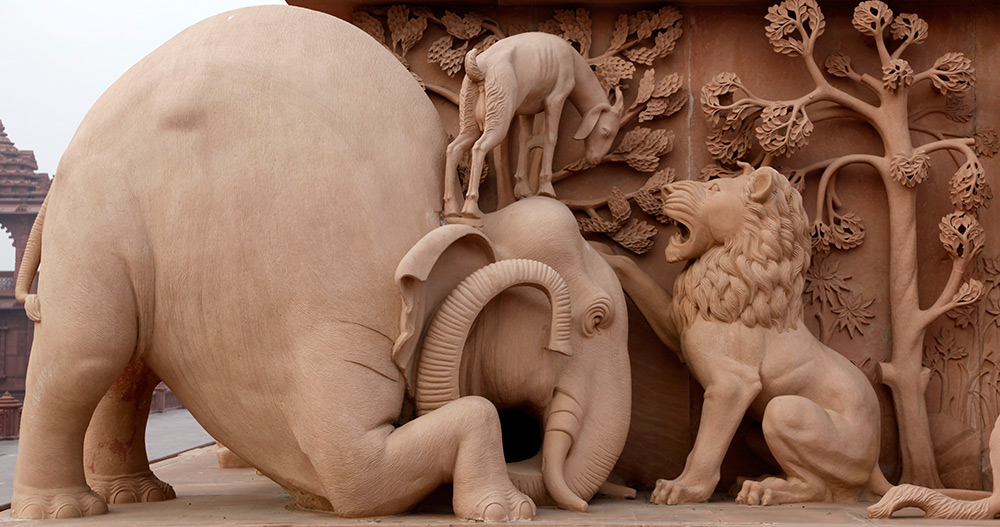
A lost goat in a dark jungle takes refuge in a lion’s footprint to save itself from being attacked by wild animals. When the lion arrives it is pacified and pleased to see the little goat’s faith in his footprint. He blesses her with protection and summons an elephant, placing the goat on the elephant's head to transport her safely and honourably to her home.
The moral of this Panchtantra story is that even an ordinary soul is protected and attains greatness by taking refuge of the great.
The moral of this Panchtantra story is that even an ordinary soul is protected and attains greatness by taking refuge of the great.
AS MUCH GOLD AS AN ELEPHANT
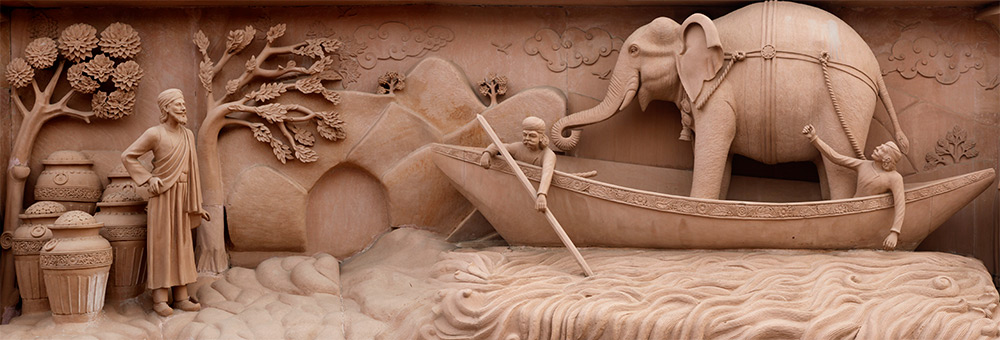
Once a king is pleased with a poet's skill and promises to reward him with gold equivalent to the weight of an elephant. But that creates a challenge - how can one weigh an elephant? A brilliant minister discovers the solution. An elephant is led into a boat. The depth to which the boat dips into the water is marked. Then the elephant is led out of the boat and the boat filled with gold till it dips to the same mark. This is the weight of gold equivalent to one elephant. The king is impressed with his minister’s intelligence – and they now know how to find the weight of an elephant.
SAMUDRA MANTHAN – CHURNING OF THE OCEAN
SAMUDRA MANTHAN – CHURNING OF THE OCEAN

The Devtas and Danavs get together to churn the ocean for 'amrut' - the nectar of immortality. Using the serpent Vasuki as a rope and Mount Mandrachal as the churning-rod, they churned out 14 precious items from the ocean, each of which is claimed by either the Devtas or the Danavs. The seven-trunked white elephant, Airavat, is claimed by Lord Indra. Airavat is seen as a symbol of auspiciousness, wealth and power.
BHIMA BRINGS AIRAVAT
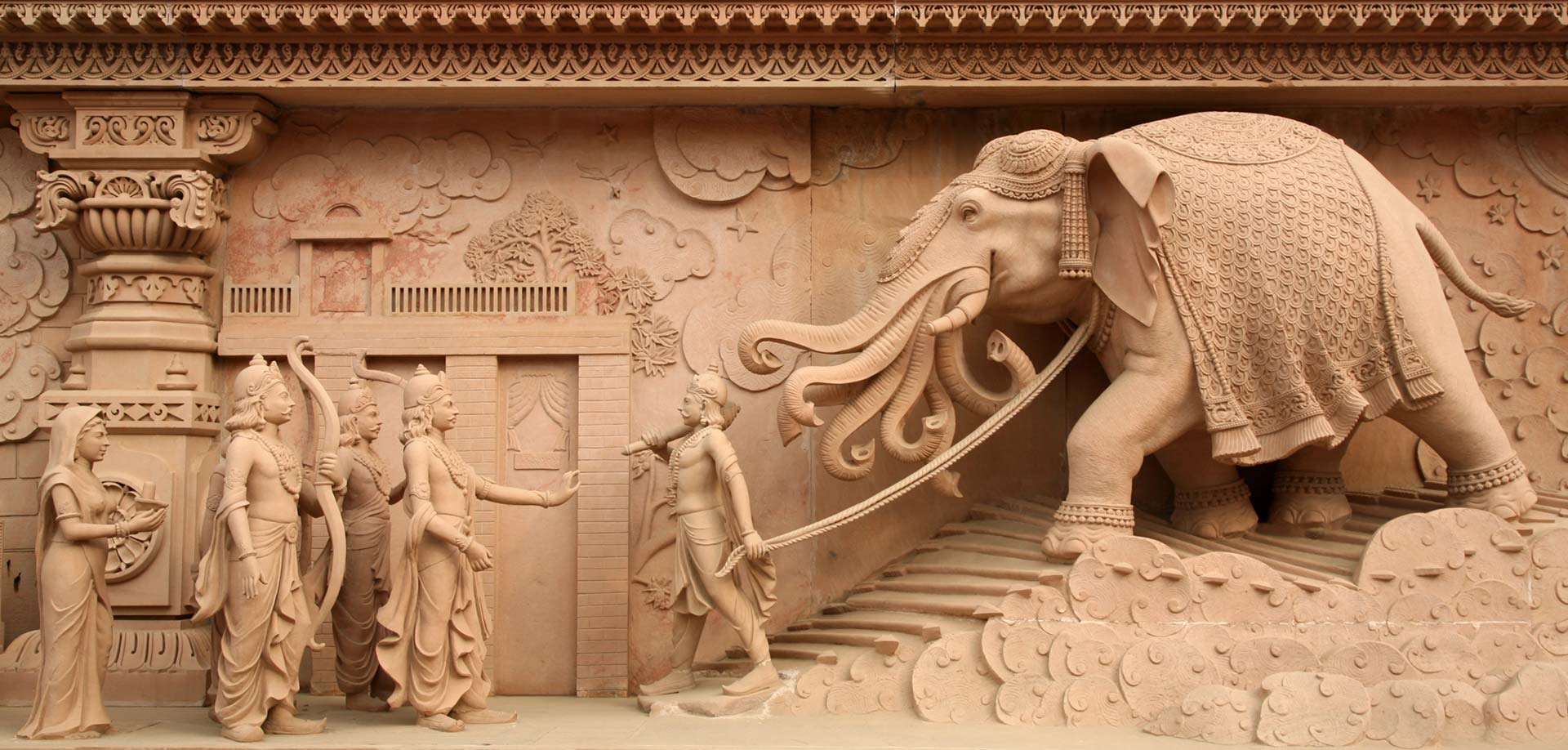
Airavat is heralded as the king of the animal world and the vehicle of Indra, ruler of the heavens. Airavat is a white elephant with seven trunks, a naturally armoured body and divine immunity to fire and injuries. When Kunti, mother of the Pandavas, sees a reflection of Airavat in the miraculous floor of the palace of Indraprastha, she wishes to see and worship it in person. To fulfill his mother's wish, Bhima reaches the heavens, defeats the forces protecting the divine elephant and proudly brings Airavat from the heavens. Bhima creates a pathway of arrows between heaven and earth for the divine elephant's descent.
This story from the Mahabharat aims to show that it is the children’s duty to fulfil their parents' wishes.
This story from the Mahabharat aims to show that it is the children’s duty to fulfil their parents' wishes.
LET BARKING DOGS BARK
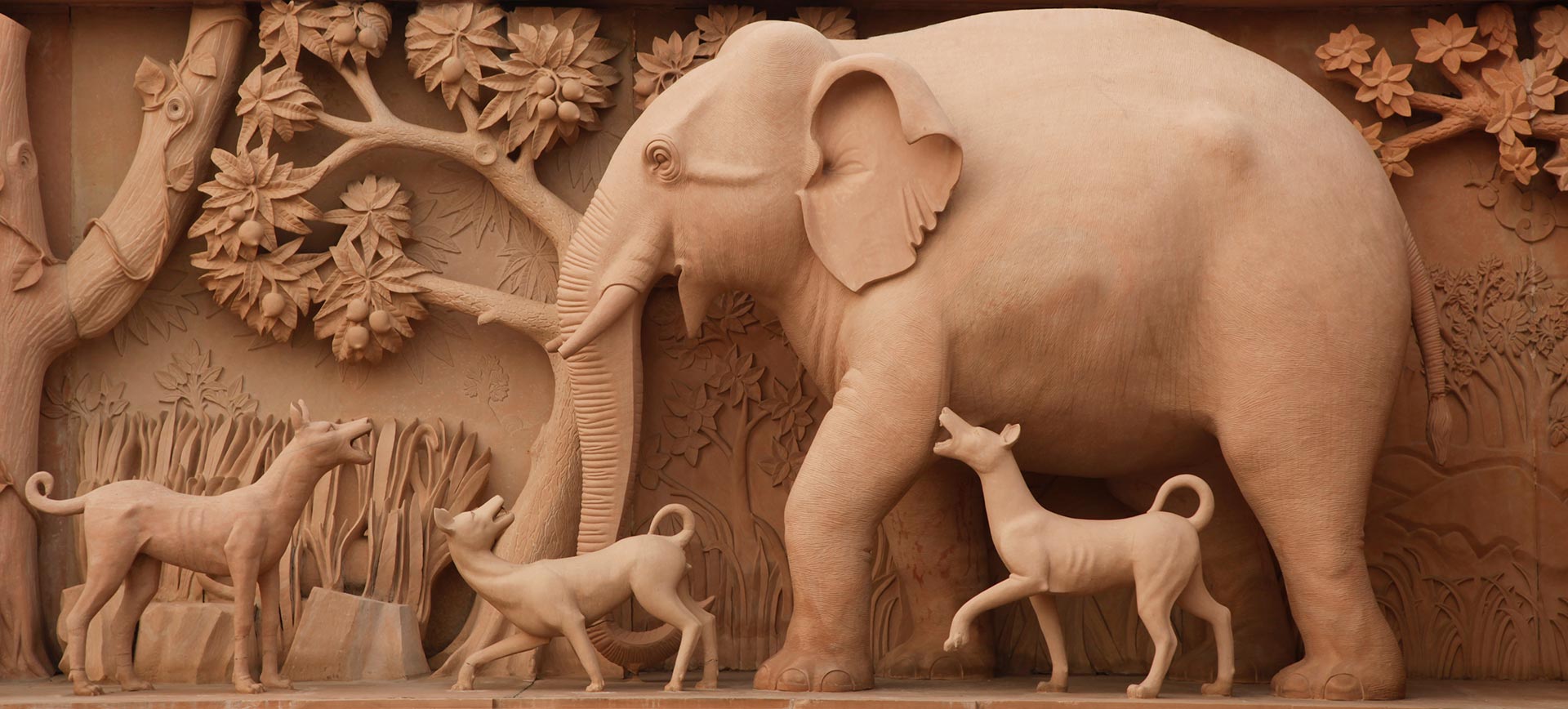
A pack of wild dogs plots against an approaching elephant. They attempt to attack it and hurt it, but the elephant is too big and strong. They decided to scare it by barking and howling, but the elephant is too grand to pay any heed. It is said that,
"Let barking dogs bark, the elephant does not stop to listen or look back, nor change its path or gait."



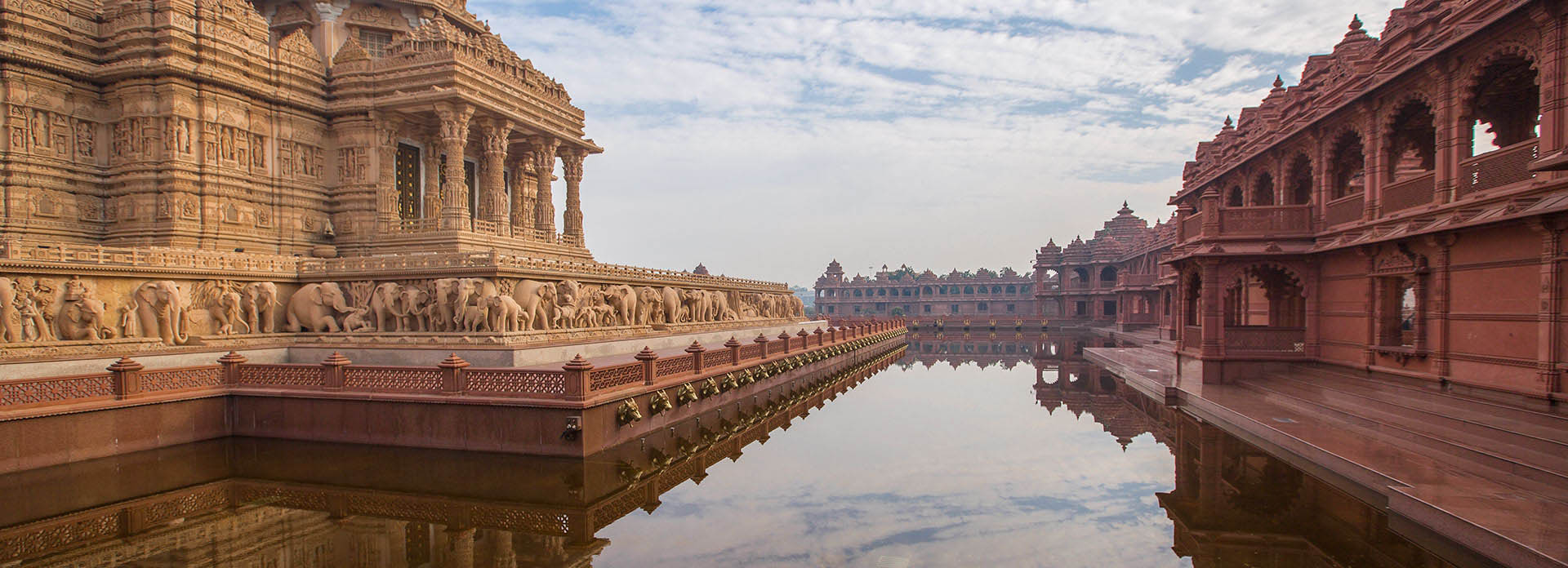
"Let barking dogs bark, the elephant does not stop to listen or look back, nor change its path or gait."
ABHISHEK MANDAP

Abhishek is the ritual bathing of a deity for the fulfilment of one’s prayers. The worshiper pours water over the deity amidst the chanting of prayers and mantras.
ABHISHEK OF NEELKANTH

Visitors can perform abhishek of the murti of Neelkanth Varni - the youthful, yogic form of Bhagwan Swaminarayan. This ritual bathing of the murti is a uniquely participatory ritual, open to all visitors.
An abhishek is most commonly accompanied by prayers for wish fulfilment.
Pramukh Swami Maharaj, spiritual leader of the BAPS Swaminarayan fellowship,
consecrated this murti of Neelkanth Varni in 2005.
An abhishek is most commonly accompanied by prayers for wish fulfilment.
Pramukh Swami Maharaj, spiritual leader of the BAPS Swaminarayan fellowship,
consecrated this murti of Neelkanth Varni in 2005.
ABHISHEK RITUAL

The abhishek ritual begins with the tying of a sacred thread on the wrist. A brief recital of sanskrit shlokas follows, after which each visitor or family bathes the murti of Neelkanth Varni with a small pot of sanctified water. During the shlokas and the bathing, visitors are encouraged to pray for their families, friends, themselves and for harmony and happiness for all.
NARAYAN SAROVAR

Since Vedic times, India has a glorious tradition of respecting rivers, lakes and stepwells. Following this tradition, a sacred water body, Narayan Sarovar, surrounds the main Akshardham mandir. Narayan Sarovar contains the holy waters of 151 rivers and lakes sanctified by Bhagwan Swaminarayan, including Manasarovar, Pushkar Sarovar, Pampa Sarovar, Indradyumna Sarovar, Manikarnika Ghat, Prayag Triveni Sangam, River Kshipra, Rivers Ganga and Yamuna and many others.
On the outer wall of the mandir are 108 bronze gaumukhs, symbolizing 108 names of God, from which holy water spouts forth.
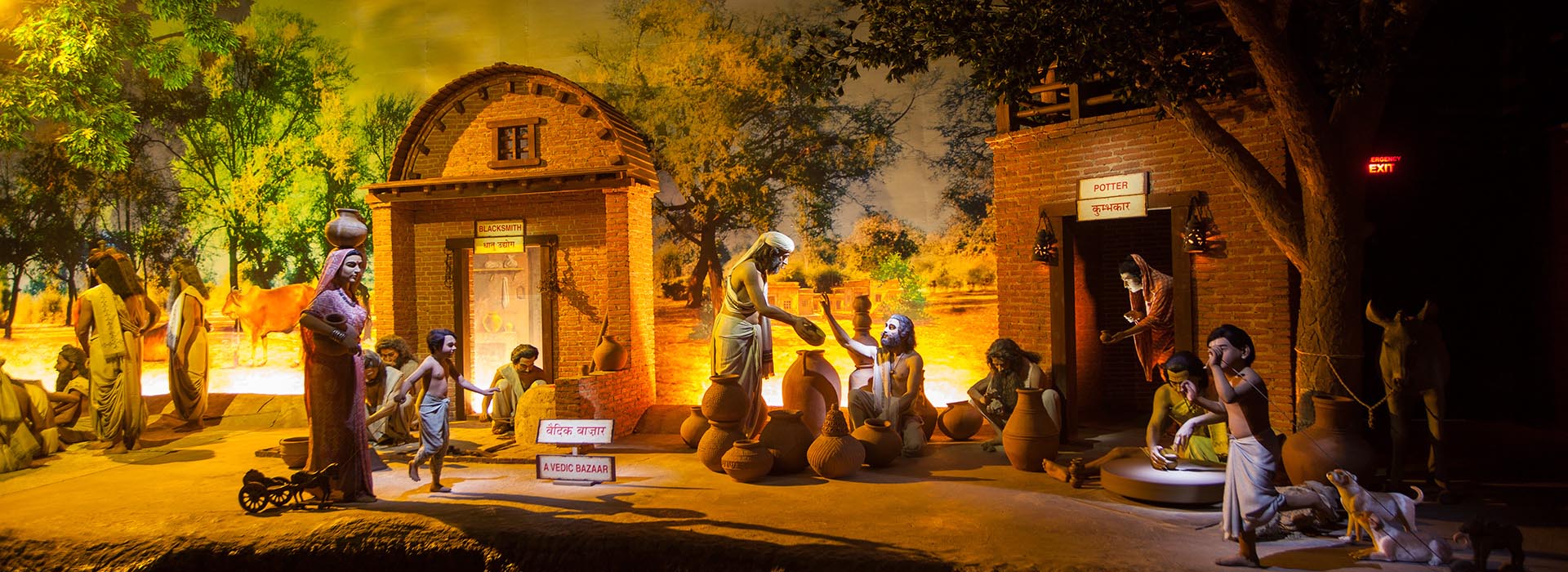




On the outer wall of the mandir are 108 bronze gaumukhs, symbolizing 108 names of God, from which holy water spouts forth.
EXHIBITIONS

The exhibitions are displayed in three large halls, each with a unique display style. A source of education, information and inspiration, they are a fourfold combination of art, science, culture and spirituality. Artistically mesmerizing, scientifically stunning, culturally moving, and spiritually elevating, the exhibitions create amazing environments capable of transporting viewers to ancient India. A balanced fusion of ancient values and wisdom and the best of modern media and technology, the exhibitions provide a powerful, soul-stirring experience of Hindu heritage and universal values. The three halls are: Sahajanand Darshan – Hall of Values; Neelkanth Darshan – Large Format Film; Sanskruti Darshan – Cultural Boat Ride.
SAHAJANAND DARSHAN – HALL OF VALUES
Visitors walk into a world of values that can help change their lives and the world. Universal values like love, ahimsa (non-violence), fearlessness, service, humility, compassion, spiritual consciousness, honesty, unity and peace are displayed through a series of exhibits using animatronic figures, scenic representations and short videos.
NEELKANTH DARSHAN – GIANT SCREEN FILM

Come and take your seat in this unique giant screen theater. Explore the highest mountains and deepest gorges of the Himalayas, trek through the rain forests of Assam and see the magnificent Rameshwaram mandir. Follow in the footsteps of Neelkanth, a youthful Bhagwan Swaminarayan, on his journey across the Indian subcontinent in this epic large format film.
SANSKRUTI DARSHAN – CULTURAL BOAT RIDE
Board a boat and sail through thousands of years of ancient Indian history. Experience the lifestyle of the Vedic era. Pass through the oldest university and watch an eye surgery happening more than a thousand years ago. This 12 minute boat ride presents some of India’s important contributions to the world.
SAHAJ ANAND – MULTIMEDIA WATER SHOW
As the sun sets, please take your seat at this traditional step well and experience an eternal truth. Transport yourself to the courtyard of the gods and watch the innocence of children challenge the powers of the mighty!
SAHAJ ANAND – MULTIMEDIA WATER SHOW
THE ARENA

The Sahaj Anand Water Show calls the Yagnapurush Kund its home. An replica of grand traditional step-wells, it measures 300’ x 300’ and has 2,870 steps and 108 small shrines. The nine-lotus design of the central pool is a replication of a ritual yantra or arrangement used in sacred Hindu ceremonies. At the head of the step-well is the 27 feet tall bronze murti of Neelkanth Varni. He presides over the step-well inspiring determination, devotion and courage in all who catch his sight.
THE SHOW

The Sahaj Anand Water Show is a breathtaking 24-minute presentation which unites a variety of intriguing media to bring to life a story from the Kena Upanishad. Multi-color lasers, video projections, underwater flames, water jets and surround sound in symphony with lights and live actors produce a captivating and inspiring presentation. International experts contributed their expertise with BAPS volunteers and sadhus to produce this one-of-a-kind presentation.
THE STORY

Children play around a lake and are amazed to see the water joining in their fun. Soon, through their dance and song, a flower is created from the water of the lake. However, their merriment disturbs the devas - gods of the elements - who are celebrating a victory over the demons. The children’s seemingly feeble flower is in danger of being destroyed by the wrath of the gods. The innocence and hope of children is pitted against the powers and ego of the devas. As events unfold, discover whether the flower survives. Learn the secret of Sahaj Anand – innate, spontaneous bliss. This story is adapted from the Kena Upanishad, one of the many treasures of knowledge and wisdom from the Vedic era.
- Get link
- X
- Other Apps


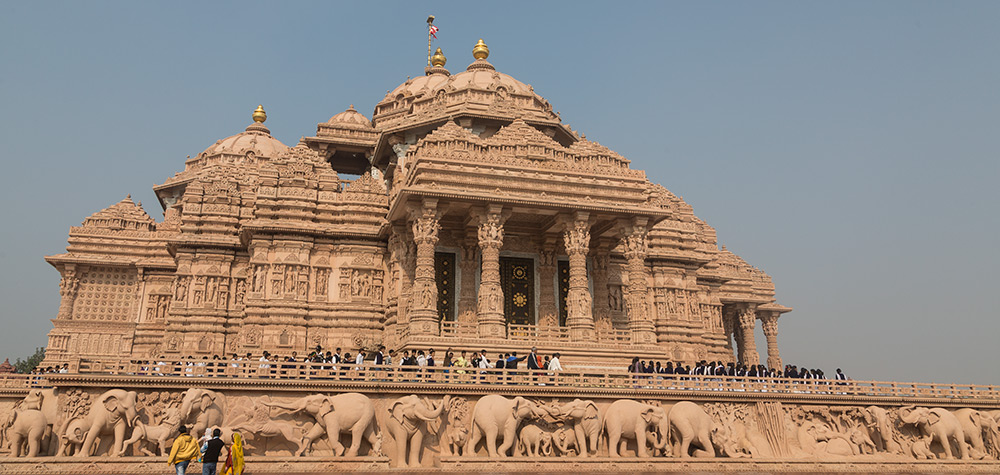


Comments
Post a Comment